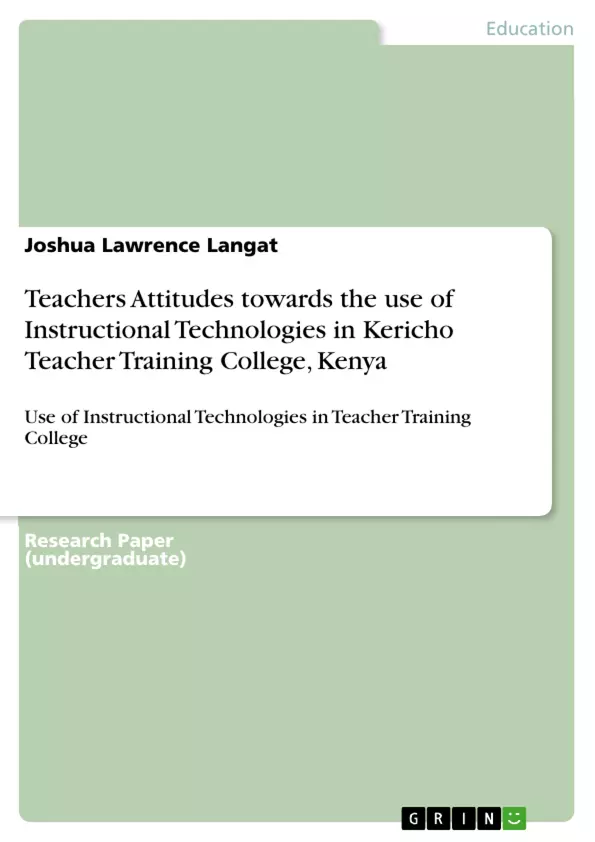The use of instructional technologies by teachers has an impact on students’ content acquisition and adds to class performance. However, research has shown that it is not only the technology that is important, but also how it is used that improves learning and increases pupils’ interest. In view of this, since not much was known about the teacher’s attitude use of technologies in training colleges in Kenya, Therefore, this study was designed to establish teachers’ attitudes towards the use of instructional technologies in Kericho teacher training college Kenya.
The technologies studied were chalkboards, flip charts, overhead projectors, videos, computers, and local resources from the environment. The design of the study was descriptive survey method involving both qualitative and quantitative research methodology. The target population for this study comprised of19 tutors. The study adopted questionnaire and Interview Guide. The researcher make used of stratified random, purposive sampling and simple random sampling. The reliability of instrument was tested using Cronbach Coefficient Alpha to determine the internal consistency of the items in the questionnaire. Statistical Package for Social Sciences (SPSS) was used to analyze data from the Questionnaire.
Data collected were analyzed and descriptively presented with frequencies and percentages, while tables were used to enhance vivid illustrations. The results of the study showed that respondents agreed on the importance of using the technologies. Despite the teaching materials helping to elaborate difficult concepts, the teachers agreed that producing them requires too much time, which to some extent threatens the availability of these self-produced teaching materials. On the other hand, the teachers were eager to learn how to use the higher-order technologies. This finding clearly shows that they need the training to be able to use the technologies. The study concludes with a suggested process for how government and the teacher training institutions can work collaboratively to maximize the use of instructional technologies in the teaching and learning process for prospective teachers. Several possibilities for further research on the use of instructional technologies have been highlighted.
Inhaltsverzeichnis (Table of Contents)
- ABSTRACT
- INTRODUCTION
- STATEMENT OF THE PROBLEM
- PURPOSE OF THE STUDY
- RESEARCH METHODOLOGY
- RESEARCH FINDINGS
- CONCLUSIONS
- RECOMMENDATIONS
- RECOMMENDATIONS AREAS FOR FURTHER RESEARCH
- REFERENCES
Zielsetzung und Themenschwerpunkte (Objectives and Key Themes)
This study aims to understand teachers' attitudes towards the use of instructional technologies in Kericho Teacher Training College, Kenya. The research explores the specific technologies used, their perceived benefits and drawbacks, and how these technologies are integrated into the teaching and learning process.
- Teacher attitudes towards instructional technologies in teacher training colleges.
- The impact of instructional technologies on student learning.
- Challenges and opportunities associated with technology integration in education.
- The role of teacher training institutions in promoting effective technology use.
- The importance of teachers as role models for technology integration in classrooms.
Zusammenfassung der Kapitel (Chapter Summaries)
- ABSTRACT: This chapter provides an overview of the study's objectives, methodology, and key findings. It highlights the importance of instructional technologies in enhancing student learning and explores the attitudes of teachers towards their use in Kericho Teacher Training College.
- INTRODUCTION: This chapter defines the concept of instructional technologies and provides a broad context for the study. It explores various definitions of instructional technologies, highlighting their role in improving teaching and learning processes. The chapter also emphasizes the importance of using locally available resources in developing countries like Kenya.
Schlüsselwörter (Keywords)
This study focuses on instructional technologies, teacher attitudes, teacher training, technology integration, educational technology, learning outcomes, and the use of technology in developing countries.
- Arbeit zitieren
- Joshua Lawrence Langat (Autor:in), 2018, Teachers Attitudes towards the use of Instructional Technologies in Kericho Teacher Training College, Kenya, München, GRIN Verlag, https://www.grin.com/document/425389



